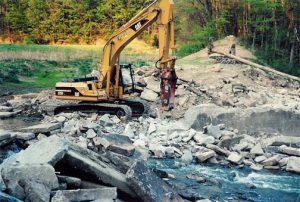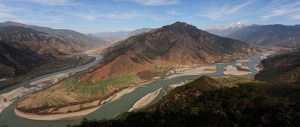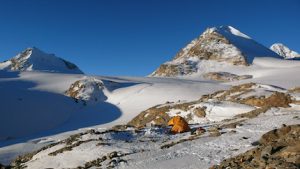One hundred and twenty-six miles from the Pacific Ocean, in Southwest Oregon’s Jackson County, the “Wild and Scenic” Rogue River lives up to its name. Swift, cold water rollicks over boulders, sweeps around a large downed tree, and rushes onward. On the south bank, Craig Tuss pauses to inspect a clump of waist-high willows sprouting from the gravel. He’s pleased. Three years ago this area – where the Gold Ray Dam once stood – resembled a drained mud wallow.
Some of the young trees began as thin whips planted by people; others sprouted on their own. Either way, the willows are a positive sign. Streamside natives like willow and cottonwood keep invasive species at bay. The new vegetation catches sediments, dissipates energy during high-water events, and provides a home for birds and insects. Up from the riverbank, small pines marked with green flags are taking root on a small bluff.
“We had to guess which areas would be true riparian habitat and which would have more upland characteristics,” Tuss says. “I think we’ve done a pretty good job.”
Tuss works for the Rogue Valley Council of Governments, the agency coordinating a comprehensive restoration and monitoring program at the former dam site. The razing of Gold Ray dam marked the last of three main stem dams removed from the Rogue River since 2008. First built as a log crib structure in 1904 and then rebuilt in 1941, the 38-foot-high and 360-foot-long Gold Ray Dam once generated hydroelectric power. When Jackson County took over the structure in 1972, the turbines stopped turning. After that, the dam served no purpose but to impound water for a small lake and sloughs used mostly by locals for recreation. For native salmon, the dam was just another obstacle blocking access to spawning areas upstream.
On the one hand, taking down a dam is simple. As soon as the barrier is removed, fish can swim up and downriver, sediment can flow downstream, and the river reclaims its course. But though rivers are incredibly resilient, dam removal is only the first step in restoring a river’s ecology, says Scott Wright, civil engineer with River Design Group, a consulting firm specialising in river restoration. Issues can include a lack of riparian vegetation, an absence of woody debris and boulders needed to create habitat complexity, disconnection from the floodplain, unfenced grazing near the channel, and unscreened diversions that attract juvenile fish.
River Design Group oversaw the initial planting and bank stabilisation at the Gold Ray site. Crews also had to clean up 100 years’ worth of rubbish, including tyres, railroad cars, and farm equipment. Then the area was replanted with native plants and trees to stall the advance of nonnative species “ready to pounce” in the dewatered area. Over time, other shrub and grasses filled in the gaps. Looking at the site today, you’d never know a concrete structure longer than a football field once spanned the river.
Returning dams to nature
The Inventory of Dams maintained by the US Army Corps of Engineers lists 79,000 dams larger than six feet and thousands of smaller ones blocking the free flow of water bodies. “Virtually every river and stream in the US has been dammed,” says Thomas Ardito, director of the Massachusetts-based Center for Ecosystem Restoration, an Earth Island project. “I look at it as a stage of development that most countries go through.” Dams were built to control floods, provide water to farms and cities, for hydroelectric power, and recreation. At one time, these dams were essential, but many have since outlived their purpose.
The call to remove dams in places where the costs outweigh the benefits has swelled in recent decades. The goals of removal are often multi-pronged: restoring river flows for fish and wildlife, reinstating the natural sediment and nutrient flow, and/or eliminating safety risks. Many dams built in the 1950s and ’60s are reaching the end of their as-built lifespans, especially in the Northeast. Older dams pose safety hazards – more than 4,000 dams in the US have been deemed at risk of collapse – and many don’t comply with current fish passage requirements set by state and federal laws.
Often, removal is less expensive than reconfiguring fish ladders and paying for routine maintenance to meet regulatory requirements. According to the conservation group American Rivers, in the past 100 years more than 1,100 dams have been removed in the US. Nearly 800 of these dams were removed in the past 20 years, including 65 in 2012 alone.
Dam removals are lining up like dominoes. At the same time as China expands its dam-building, the US is undergoing its most ambitious ever dam decommissioning program: the demolition of two big dams on the Elwha River in Washington State’s Olympic National Park. The largest dam removal in California is occurring on the Carmel River, as the outdated San Clemente Dam is brought down to make way for steelhead spawning. Two dams on Maine’s Penobscot River are slated for demolition, and another pair of dams has come down on the Chattahoochee River in Georgia. Four dams on the Klamath River, which runs through Oregon and California, are scheduled for removal.
Opposition to removing dams
Yet proposals to remove dams are almost always contentious, pitting local communities – which value the recreational opportunities and aesthetics of reservoirs, and the historic heritage of the dam itself – versus scientists, environmentalists, and Native American tribes, who prioritise restoring a river’s hydrology, ecology, and fish runs. Some ranchers near the Rogue River, for example, opposed the dams’ removal. “We lobbied strongly to keep the dam from being taken out,” says 81-year-old Dalton Straus, an area rancher. “But I’ve tried to maintain a civil attitude.”
That doesn’t always happen. Compromise solutions are notoriously difficult to reach; a decision to remove or keep the dam always results in one side losing. “The technical issues can generally be addressed; the biggest challenges tend to be social,” says Denise Hoffert-Hay, associate director of river restoration with American Rivers.
Exhaustive impact studies must take place before federal, state, and local agencies will grant the permits required to take down a dam. “If anything, we end up doing too many studies,” Ardito says.
In contrast, long-term post-dam removal studies have been few and far between. “There are two places it’s hard to find funding: the beginning and the end,” Hoffert-Hay says. “Anything after removal is no longer considered restoration.”
Monitoring projects cost a fraction of the dam removal itself, and can help scientists to understand the immediate and long-term effects of removal. “To really capture the recovery of a river or wetland you need about 10 years of monitoring, but that kind of work is hard to fund,” Ardito says.
Serena McClain, director of river restoration at American Rivers, says sites that receive comprehensive monitoring can serve as indexes, informing future dam-removal projects. Long-term studies that show how dam removal can benefit both a region’s ecology and economy can help depolarise the politics around decommissioning.
Even those in favour of removing a dam sometimes worry about the load of sediment waiting behind the structure: Will the released material bury downstream habitats, threaten infrastructure, impair water quality, or let loose contaminants like heavy metals? Desiree Tullos, a biological and ecological engineering professor at Oregon State University, measured changes in channel shape and elevation and tracked the movement of sediment through surveys at Gold Ray. She found that the sediment level dropped right above the dam and rose just below it; most of the riverbank erosion occurred immediately upstream and most deposition occurred within the first 2,800 meters downstream.
Tullos has also measured fish and aquatic insect response to geo-physical changes one and two years after removal. “The question is, ‘Does dam removal act as a disturbance that ecosystems detect?’” Tullos says. Based on her research, she concludes that the answer is, not really.
Although Tullos cautions against making generalisations based on dams in the Pacific Northwest, her work can inform future removals, says American Rivers’ Hoffert-Hay. “Her research has found that a lot of things feared with dam removal – including an uncontrolled release of a large quantity of sediment with cascading downstream effects – just don’t happen.”
There have been some problems, with several wells upstream of the former dam at Gold Ray drying up. Downstream, debris clogged river water intakes belonging to a dozen property owners. Jackson County responded by digging new wells and offering financial and technical assistance to landowners with clogged intakes, trucking water to the landowners in the interim.
On the socioeconomic side, Dr. Eva Skuratowicz, a sociologist at the Southern Oregon Research Center, has been investigating the impacts of the Gold Ray Dam removal through visitor counts, and interviews with visitors and fishing and rafting guides in Southern Oregon. Rafting is big business in this region. Skuratowicz found that TouVelle State Park, 11 miles upstream from the former Gold Ray Dam, has become a preferred put-in. Several companies now offer one-day trips that combine a calm float past the former impoundment area with the thrill of Class 3 and Class 4 rapids below it – trips that weren’t possible just a few years before.
“In general, usage has shifted away from the dam site, both upstream and downstream,” she says. But recreational activities – from fishing and rafting to swimming and picnicking – have increased across the board, especially at TouVelle. Some fishing guides complained about turbidity following the dam removal, but reported an overall upward trend in revenues. Skuratowicz points out that the health of the economy and fish runs factor in, too. Most guides said they’ve expanded their guiding area, and noted improvements in the appearance and behaviour of fish. “Because we haven’t seen many negative changes, [this study] can help alleviate fears about future removals,” Skuratowicz says.
The return of the fish industry
For many in the Northwest, the dam removals on the Rogue mean one thing: more salmon. Opening up 157 miles of river has clearly benefited the five runs of migratory fish – Spring Chinook, Fall Chinook, Summer Steelhead, Winter Steelhead, and federally threatened Coho – that spawn in the Rogue and its tributaries.
Dams physically block native fish movements. Sometimes fish make it past the barriers, but the extra effort costs them precious energy. The fish ladder at Savage Rapids, for instance, was long, with multiple entrances. Salmon often eschewed it in favour of leaping fruitlessly against the spillway. And seasonal drawdowns of the reservoir sent a mini-tsunami downstream, stranding fish after it receded.
Dan Van Dyke, fish biologist for the Oregon Department of Fish and Wildlife, has been counting redds – that is, fish “nests” – at Gold Ray each fall since the dam was removed. Chinook began spawning in the new habitat immediately. “It’s almost to the point where we can’t count them all,” says Van Dyke. Anecdotal reports of healthier fish and earlier returns keep flowing in, but Van Dyke is careful to not make any general statements about abundance. “Runs are up since the dams were removed,” he says, “but ocean productivity is also up.”
“One of the biggest benefits of this project is going from standing water to the free-flowing river native fish evolved with,” Van Dyke says. Reservoirs can concentrate fish and make them more susceptible to predators and poaching. Conditions behind dams also tend to favour fish that prefer deeper, standing water. Often these are deliberately introduced nonnatives like largemouth bass. Preliminary results of a study of “fish assemblages” – the numbers and proportions of native and nonnative fish – at several locations around the Gold Ray dam site show the proportion of salmon rising at both sites.
This fall the first generation of salmon to have spawned on an undammed Rogue River returned to their natal waters. As they swam upstream from the ocean, they encountered a river freer than it has been in more than a century. There were no barriers, no fish ladders. Just the river, redefining itself with every new season.
This article was first published by the Earth Island Journal. Freelance writer Juliet Grable lives in Southern Oregon, where she frequently writes about watershed issues







